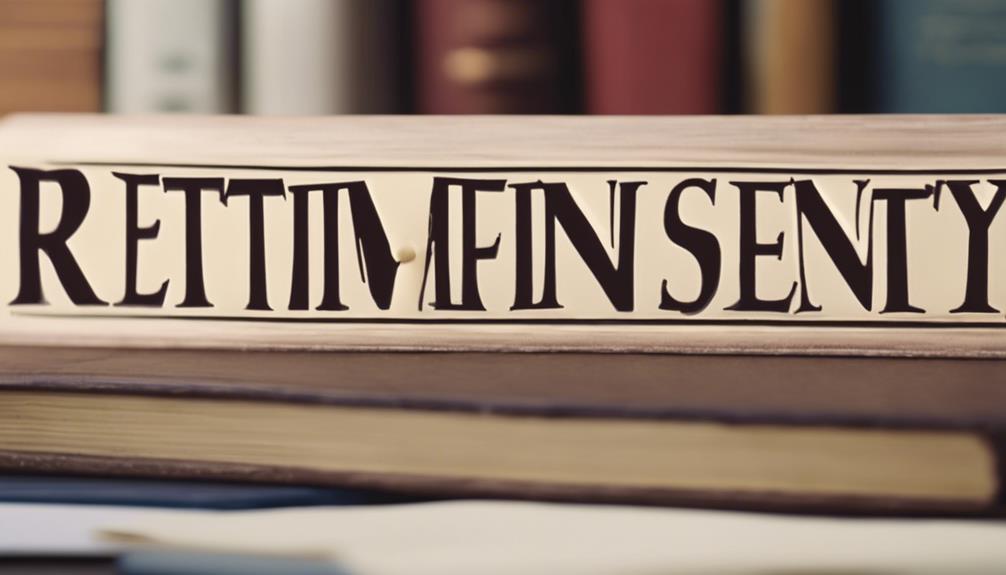When thinking about retiring, it is important to consider key plans such as Traditional and Roth IRAs, which provide tax benefits and long-term security. 401(k) Plans with Employer Match can offer additional funds and help boost savings. Annuities guarantee income throughout retirement, ensuring stability. Target-Date Funds adjust investments based on age to align with financial goals. Backdoor Roth IRAs offer tax-efficient growth, enhancing savings. It is crucial to maximize contributions and take advantage of catch-up options to build a strong nest egg. Employing tax-efficient strategies like Roth IRAs and strategic allocations can optimize savings potential. Explore the top 10 retirement plans for a secure financial future.
Key Takeaways
- Maximize contributions to Traditional IRA or Roth IRA for tax advantages.
- Consider 401(k) plans with employer match for free money towards savings.
- Explore annuities for guaranteed income during retirement.
- Utilize target-date funds for automatic asset allocation adjustments.
- Implement tax-advantaged strategies like Health Savings Accounts or Backdoor Roth IRAs.
Traditional IRA
When considering retirement planning, Traditional IRAs offer tax advantages and a secure way to grow your nest egg over time. Contributing to a traditional IRA can lower your taxable income for the year, potentially placing you in a lower tax bracket. This tax-deductible feature allows you to save more of your hard-earned money for retirement.
Additionally, the earnings on your investments within a traditional IRA are tax-deferred until you start making withdrawals in retirement, providing an opportunity for your savings to grow faster. Traditional IRAs are tailored for individuals with taxable income, making them a strategic choice for those aiming to maximize their retirement savings.
Roth IRA

Moving from the benefits of a Traditional IRA to exploring the advantages of a Roth IRA, this retirement option offers tax-free withdrawals in retirement, making it a valuable tool for future financial security. Roth IRA contributions are made with after-tax dollars, ensuring that withdrawals during retirement are tax-free.
Eligibility for contributing to a Roth IRA is limited to individuals with taxable income of $144,000 or less annually, providing an opportunity for many to benefit from this retirement account. One key advantage of Roth IRAs is the ability to withdraw contributions penalty-free, offering flexibility for savers in times of need.
Unlike traditional IRAs, Roth IRAs don't mandate minimum distributions during the owner's lifetime, allowing for more control over the funds. This makes Roth IRAs particularly appealing for those aiming for tax-free growth and withdrawals in retirement, providing a powerful financial planning option for future security.
401(K) Plans With Employer Match

When considering retirement plans, (K) plans with employer match are a key option to secure future financial stability.
The employer match provides a valuable opportunity to grow retirement funds faster by receiving free money towards savings.
Taking advantage of this benefit can greatly boost retirement security, making it a smart strategy for long-term financial planning.
Matching Contribution Benefits
Matching contribution benefits in (K) plans with employer match can greatly enhance your retirement savings. Employers match a portion of your contributions, effectively doubling your retirement fund. By taking advantage of this benefit, you're basically receiving free money towards your savings.
Employers typically match a percentage of your contributions up to a set limit, providing a significant boost to your retirement nest egg. This strategy can help you reach your financial goals faster and maximize your retirement savings potential.
Ensuring you contribute enough to receive the full employer match is a smart approach to securing a more financially stable future. Make the most of these matching contributions to set yourself up for a comfortable retirement.
Tax-Deferred Savings Option
Exploring the tax-deferred savings option in Traditional 401(k) plans with employer match can greatly enhance our retirement funds. By making tax-deferred contributions to our 401(k) accounts, we can lower our current taxable income while allowing our investments to grow tax-free until withdrawal.
The added benefit of employer matching further boosts our savings potential, providing us with additional funds for retirement. Traditional 401(k) plans offer a powerful way to maximize our retirement savings through tax advantages and employer contributions. By taking advantage of these features, we can secure a strong financial future and build a solid foundation for our retirement years.
It's crucial to carefully assess these options and make the most of the benefits they offer for long-term financial security.
Annuities for Guaranteed Income

Annuities provide a reliable source of guaranteed income during retirement, ensuring a steady stream of payments for a specified period. These insurance products, offered by companies, can be fixed or variable, with fixed annuities providing a set payout and variable ones linking payments to investment performance.
By purchasing annuities, individuals secure a dependable income stream, safeguarding against the risk of outliving their savings. Customizable options within annuities allow for tailoring to specific needs, such as inflation protection or survivor benefits.
These products offer a powerful tool for securing financial stability in retirement, offering peace of mind and a sense of security. Consider exploring the various types of annuities available to determine which best aligns with your retirement goals and risk tolerance. Planning for guaranteed income through annuities can provide a solid foundation for a financially stable retirement.
Target-Date Funds

Target-date funds are a convenient investment option that automatically adjusts your asset allocation based on your target retirement date. As you near retirement, these funds gradually shift to a more conservative mix of investments, moving from stocks to bonds and cash equivalents.
This hands-off approach simplifies the investment process by providing a diversified portfolio in a single fund tailored to align with your retirement goals.
Investment Diversification Strategies
Diversifying investments through target-date funds can provide a secure retirement plan by automatically adjusting asset allocation based on the investor's target retirement date. These funds offer a mix of stocks, bonds, and cash equivalents, balancing risk and return. By selecting a target-date fund aligned with their expected retirement year, investors can benefit from a hands-off approach to investing.
As the retirement date nears, these funds shift towards a more conservative investment strategy, safeguarding accumulated wealth. This strategic asset allocation guarantees that the portfolio is managed effectively, optimizing returns while minimizing risks. Target-date funds provide a convenient and efficient way for individuals to plan for retirement, offering a straightforward path towards financial security.
Retirement Date Alignment
When planning for retirement, aligning your target date with a suitable target-date fund can streamline your investment strategy for future financial security. Target-date funds automatically adjust asset allocation based on your retirement date, shifting from aggressive to conservative investments as you approach retirement. These funds offer a diversified portfolio managed by professionals to align with your chosen target retirement year, optimizing growth and reducing risk over time.
Risk Management Approach
As investors approach their retirement date, a key aspect to contemplate is the risk management approach embedded within target-date funds. These funds, commonly offered in retirement plans like 401(k)s and IRAs, automatically adjust asset allocation based on the investor's target retirement date.
They're designed to shift gradually from higher-risk investments to more conservative options as retirement nears. By choosing a target-date fund aligned with their expected retirement year, typically ranging from 5 to 30 years in the future, individuals can simplify their investment process.
Target-date funds provide a diversified portfolio that caters to their retirement timeline, offering a hands-off approach to managing retirement savings. Consider incorporating target-date funds into your retirement strategy for a streamlined and effective risk management approach.
Health Savings Accounts (HSAs)

Emphasizing the importance of proactive healthcare planning, Health Savings Accounts (HSAs) serve as a tax-efficient vehicle for individuals to save for future medical needs. These tax-advantaged accounts are specifically designed to help individuals set aside funds for qualified medical expenses. Contributions made to HSAs are tax-deductible, and the money grows tax-free. Additionally, withdrawals for eligible medical expenses are also tax-free, providing a triple tax advantage.
To be eligible for an HSA, individuals must have high-deductible health insurance plans, and the funds in the account can roll over from year to year, making it a valuable tool for long-term healthcare savings.
HSAs offer a flexible and beneficial option for future healthcare expenses in retirement. They can be used to cover a wide range of medical costs, ensuring that individuals have financial support when needed. By utilizing an HSA, individuals can secure their future health needs while benefiting from the tax advantages it offers.
Backdoor Roth IRAs

When considering retirement planning options, Backdoor Roth IRAs can be a tax-efficient strategy for high-income individuals. By converting a traditional IRA into a Roth IRA, one can potentially benefit from tax-free growth and withdrawals in retirement.
It's essential to understand the contribution limits and rules associated with this method to maximize its advantages for future security.
Tax-Efficient Retirement Savings
Exploring tax-efficient retirement savings through Backdoor Roth IRAs provides high-income earners with a strategic way to boost their retirement security.
By utilizing this method, individuals can contribute to a Roth IRA even if they surpass the income limits typically associated with direct contributions.
The process involves making non-deductible contributions to a traditional IRA and then converting those funds into a Roth IRA.
This approach offers the advantage of tax-free growth and withdrawals during retirement, ultimately enhancing long-term financial security.
Following the IRS guidelines is essential when implementing the backdoor Roth IRA strategy to guarantee compliance with regulations.
Incorporating Backdoor Roth IRAs into retirement planning can yield additional savings and tax benefits for those with higher incomes.
Contribution Limits and Rules
To maximize retirement savings and take advantage of the benefits of Backdoor Roth IRAs, understanding the contribution limits and rules is key. For Roth IRAs in 2021, individuals under 50 can contribute up to $6,000, while those 50 and older can contribute up to $7,000.
The Backdoor Roth IRA strategy allows high-income earners to make indirect contributions by first funding a traditional IRA and then converting it to a Roth IRA. This conversion process enables individuals to benefit from tax-free withdrawals in retirement.
One important aspect of Backdoor Roth IRAs is that individuals can make nondeductible contributions to traditional IRAs and then convert them to Roth IRAs without being restricted by income limits. By following these rules and limits, individuals can strategically plan for a secure financial future.
Maximizing Contributions for Savings

Maximizing contributions to retirement plans such as 401(k)s and IRAs is essential for building a substantial nest egg for future security. By taking advantage of employer-sponsored retirement plans, you can make the most of contribution limits set by traditional retirement accounts, ensuring you save as much as possible.
For individuals aged 50 and older, utilizing catch-up contributions is a powerful tool to boost retirement savings significantly. These extra contributions can make a substantial difference in the size of your retirement fund over time.
Additionally, considering employer matching contributions as free money towards your retirement savings can further enhance your financial security. By understanding the annual contribution limits for different retirement plans and strategically allocating your funds, you can optimize your savings potential and secure a more comfortable retirement.
Planning wisely and maximizing contributions now will lead to a more financially empowered future.
Tax-Efficient Strategies

Utilizing tax-efficient strategies is key to optimizing retirement savings and ensuring future financial security. One effective method is to explore Roth IRAs, which offer tax-free withdrawals in retirement, making them a valuable tool for long-term financial planning.
Traditional 401(k) plans also play an important role by allowing contributions with pre-tax dollars, contributing to tax-efficient retirement savings. Additionally, maximizing employer matching contributions in retirement plans can further enhance tax-efficient strategies for financial security.
For high-income earners, utilizing backdoor Roth IRAs can be a tax-efficient way to boost retirement savings. It's important to understand the tax implications of different retirement plans, such as Roth versus traditional accounts, to create a well-rounded tax-efficient retirement strategy.
Catch-Up Contributions

As we consider strategies to optimize retirement savings, one valuable approach is through catch-up contributions. These contributions enable individuals aged 50 and older to add extra funds to their retirement accounts, enhancing their overall financial security.
In 2021, the catch-up contribution limit for 401(k) plans is $6,500 on top of the standard contribution limit, while for traditional and Roth IRAs, it stands at $1,000 in addition to the standard limit. By taking advantage of catch-up contributions, individuals can greatly boost their retirement savings as they near retirement age.
These additional contributions are specifically designed to help older individuals make up for any shortfalls in their retirement savings, providing an important opportunity to better prepare for the future. Leveraging catch-up contributions is a proactive step towards securing a more comfortable retirement and ensuring financial stability in the later stages of life.
Frequently Asked Questions
What Is the $1000 a Month Rule for Retirement?
We save for retirement following the $1000 a Month Rule, aiming to set aside $240,000 for every $1000 we expect to spend monthly in retirement. This rule guides our planning, ensuring we prepare adequately for future financial security.
What Are the Two 2 Most Popular Personal Retirement Plans?
We've got Traditional IRAs and Roth IRAs, the top picks for personal retirement plans. Traditional IRAs offer tax breaks, and Roth IRAs give tax-free withdrawals. Knowing the nuances can help us secure our financial future.
Where Is the Safest Place to Put Your Retirement Money?
We believe the safest place to put our retirement money is in FDIC-insured bank accounts, Treasury securities, CDs, and money market accounts. These options offer security and stability for our future financial well-being.
What Is the New Retirement Policy in 2024?
We can't ignore the 2024 retirement policy changes – raising RMD age, boosting catch-up contributions, and introducing tax credits for businesses offering retirement plans. Roth options are expanding, and automatic enrollment is encouraged.
Conclusion
To sum up, it's crucial to start planning for retirement early and consider a variety of options to secure your future. Remember, it's never too late to start saving for retirement, and the sooner you begin, the better off you'll be in the long run. Additionally, creating a **stepbystep retirement plan** can help you set clear goals and track your progress over time. This plan should include aspects such as budgeting, investment strategies, and emergency savings to ensure a well-rounded financial safety net. Ultimately, the more prepared and organized you are, the more peace of mind you'll have as you approach your retirement years.
So, don't put all your eggs in one basket – explore different retirement plans to find what works best for you. After all, a stitch in time saves nine!










